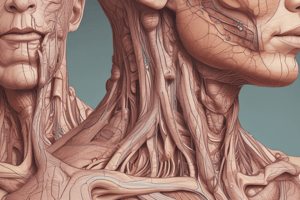Podcast
Questions and Answers
Which layers of the skin does the stratum germinativum belong to?
Which layers of the skin does the stratum germinativum belong to?
- Epidermis (correct)
- Dermis
- Hypodermis
- Subcutaneous tissue
What structure is directly involved in tanning?
What structure is directly involved in tanning?
- Sudoriferous glands
- Arrector pili muscles
- Apocrine glands
- Melanocytes (correct)
What is covered with vernix caseosa?
What is covered with vernix caseosa?
- A toddler
- A fetus (correct)
- The pregnant uterus
- A pregnant woman
Which term is most descriptive of sudoriferous glands?
Which term is most descriptive of sudoriferous glands?
What appearance does a person have when the blood vessels of the skin dilate?
What appearance does a person have when the blood vessels of the skin dilate?
What do ceruminous glands secrete?
What do ceruminous glands secrete?
What causes freckles and moles?
What causes freckles and moles?
What is a consequence of a congenital absence of eccrine glands?
What is a consequence of a congenital absence of eccrine glands?
What effect does shivering have on the body?
What effect does shivering have on the body?
Which of the following skin conditions typically carries the poorest prognosis?
Which of the following skin conditions typically carries the poorest prognosis?
Which layer insulates the body from extreme temperature changes?
Which layer insulates the body from extreme temperature changes?
Which of the following structures is avascular?
Which of the following structures is avascular?
What is the name of the yellow pigment found in the skin?
What is the name of the yellow pigment found in the skin?
Which substance is produced by the skin and aids in calcium absorption?
Which substance is produced by the skin and aids in calcium absorption?
Hair loss due to anticancer drugs is called:
Hair loss due to anticancer drugs is called:
Sweat glands associated with hair follicles in the axillary and genital areas are called:
Sweat glands associated with hair follicles in the axillary and genital areas are called:
Which layer contains cutaneous blood vessels, free nerve endings, and arrector pili muscles?
Which layer contains cutaneous blood vessels, free nerve endings, and arrector pili muscles?
Which statement is LEAST descriptive of the dermal layer?
Which statement is LEAST descriptive of the dermal layer?
Which structure consists of continuously dividing cells that push older cells toward the surface?
Which structure consists of continuously dividing cells that push older cells toward the surface?
Which of the following is TRUE of the stratum corneum?
Which of the following is TRUE of the stratum corneum?
Which of the following is TRUE of the subcutaneous layer?
Which of the following is TRUE of the subcutaneous layer?
What is the primary function of melanocytes?
What is the primary function of melanocytes?
What does cyanosis indicate?
What does cyanosis indicate?
What is a key characteristic of sebaceous glands?
What is a key characteristic of sebaceous glands?
Shivering is a process that:
Shivering is a process that:
Brown fat in newborns is primarily involved in:
Brown fat in newborns is primarily involved in:
Rectal temperature provides a measurement of:
Rectal temperature provides a measurement of:
Keratin is a protein that:
Keratin is a protein that:
Which statement is LEAST accurate regarding the epidermis?
Which statement is LEAST accurate regarding the epidermis?
Exfoliation and desquamation refer to:
Exfoliation and desquamation refer to:
Dander and dandruff consist of:
Dander and dandruff consist of:
Hirsutism is often related to:
Hirsutism is often related to:
Flashcards
Epidermis
Epidermis
The outer layer of the skin, composed of the stratum germinativum and stratum corneum.
Melanocytes
Melanocytes
Cells that produce melanin, responsible for skin pigmentation or tanning.
Vernix Caseosa
Vernix Caseosa
A whitish, cheese-like substance covering the skin of the fetus.
Sudoriferous
Sudoriferous
Signup and view all the flashcards
Ceruminous Glands
Ceruminous Glands
Signup and view all the flashcards
Congenital Absence of Eccrine Glands Consequence
Congenital Absence of Eccrine Glands Consequence
Signup and view all the flashcards
Mechanisms of Heat Loss
Mechanisms of Heat Loss
Signup and view all the flashcards
Arrector Pili Muscles
Arrector Pili Muscles
Signup and view all the flashcards
Shivering Effect
Shivering Effect
Signup and view all the flashcards
Melanoma
Melanoma
Signup and view all the flashcards
Subcutaneous Layer
Subcutaneous Layer
Signup and view all the flashcards
Avascular Epidermis
Avascular Epidermis
Signup and view all the flashcards
Carotene
Carotene
Signup and view all the flashcards
Vitamin D
Vitamin D
Signup and view all the flashcards
Alopecia
Alopecia
Signup and view all the flashcards
Vasodilation
Vasodilation
Signup and view all the flashcards
Dermis
Dermis
Signup and view all the flashcards
Stratum Germinativum
Stratum Germinativum
Signup and view all the flashcards
Stratum Corneum
Stratum Corneum
Signup and view all the flashcards
Cyanosis
Cyanosis
Signup and view all the flashcards
Eccrine Glands
Eccrine Glands
Signup and view all the flashcards
Apocrine Glands
Apocrine Glands
Signup and view all the flashcards
Shivering
Shivering
Signup and view all the flashcards
Brown Fat
Brown Fat
Signup and view all the flashcards
Rectal Temperature
Rectal Temperature
Signup and view all the flashcards
Keratin
Keratin
Signup and view all the flashcards
Exfoliation/Desquamation
Exfoliation/Desquamation
Signup and view all the flashcards
Dander and Dandruff
Dander and Dandruff
Signup and view all the flashcards
Hirsutism
Hirsutism
Signup and view all the flashcards
Sudoriferous Glands
Sudoriferous Glands
Signup and view all the flashcards
Study Notes
- The stratum germinativum and stratum corneum are layers of the epidermis.
- Tanning is associated with melanocytes.
- A fetus is covered with vernix caseosa
- "Sweat" describes sudoriferous.
- When blood vessels of the skin dilate, the person appears flushed.
- Ceruminous glands secrete wax in the outer ear.
- Freckles and moles result from an accumulation of melanin.
- A congenital absence of eccrine glands leads to an inability to regulate body temperature.
- Radiation, conduction, convection, and evaporation are terms related to heat loss.
- Hives are called urticaria.
- Skin supplied by oxygen-poor blood is described as cyanotic.
- The dermis lies on the subcutaneous layer.
- Keratin makes the skin water resistant.
- Contraction of the arrector pili muscles results in goosebumps.
- Sebaceous glands secrete vernix caseosa in the fetus.
- Sebaceous glands are most likely to develop a blackhead or pimple.
- Apocrine glands are most responsible for body odor.
- Mammary glands and ceruminous glands are modified sweat glands.
- Constriction of blood vessels conserves heat.
- Exercising causes sweating and flushing to lose heat.
- Shivering increases heat production.
- Melanoma has the poorest prognosis.
- The subcutaneous layer insulates the body from extreme temperature changes.
- The epidermis is avascular.
- Carotene is the yellow pigment found in skin.
- Vitamin D, produced by the skin, is necessary for calcium absorption.
- Anticancer drugs often cause hair loss, a condition called alopecia.
- Sweat glands usually associated with hair follicles and found in the axillary and genital areas are called apocrine glands.
- Vasodilation is most likely to lower body temperature.
- A callus is the name of the thickening of the epidermis that develops in response to constant pressure or irritation.
- The stratum germinativum is mitotically active.
- The secretion of fetal sebaceous glands results in the fetus being covered by vernix caseosa.
- The hypodermis is also called the subcutaneous layer.
- Sebaceous, apocrine, and eccrine glands are exocrine.
- Nonshivering thermogenesis is accomplished by metabolism associated with brown fat.
- The epidermal layer is nourished by blood vessels in the dermal layer.
- A characteristic of the dermal layer is that it is nourished by blood vessels in the epidermal layer.
- The cells are continuously dividing, pushing older cells toward the surface of the cutaneous membrane indicates the stratum germinativum.
- The stratum corneum is (a) the outermost layer of the epidermis, (b) an epidermal layer, and (c) nourished by blood vessels within the dermis.
- The subcutaneous layer contains adipose tissue, and cushions, binds, and insulates.
- Melanocytes secrete a tanning pigment in response to exposure to sunlight.
- Cyanosis refers to a bluish coloring of the skin caused by hypoxemia.
- Sebaceous glands are exocrine glands.
- Eccrine glands are sweat glands.
- Apocrine glands become active at puberty, are exocrine glands, and are found primarily in the axillary and genital areas.
- Vernix caseosa is a cream cheese-like substance covering the skin of the fetus.
- The hypothalamus is the body's thermostat, can be affected by pyrogens, and is involved in thermoregulation.
- Flushing is generally accompanied by activation of the eccrine glands to lose heat.
- Shivering produces heat.
- Brown fat is found in the fetus and neonate and is concerned with nonshivering thermogenesis.
- Rectal temperature is a measurement of core temperature.
- Keratin is a protein that hardens and makes an epidermal cell water resistant.
- The epidermis does not sit on the subcutaneous layer
- Exfoliation and desquamation is the sloughing off of dead cells by the stratum corneum.
- Dander and dandruff are composed of dead skin cells.
- Hirsutism may occur in response to abnormal secretion of hormones such as steroids.
- The hair follicle is composed of epithelial cells.
- With aging hair becomes gray and then white as melanocytes become less active.
- Sudoriferous glands are sweat glands, participate in temperature regulation, and include eccrine and apocrine glands.
- Normal body temperature is maintained through thermoregulatory mechanisms.
- Using a cooling blanket to lower body temperature works through conduction.
- A person feels warmer on a humid day because the decrease in evaporation of water from the skin surface decreases the loss of heat.
- Hyperthermia is characterized by elevated body temperature, the elevated temperature caused by the inability of the body to get rid of excess heat, and does not respond to the antipyretic effect of aspirin.
- A fever involves the upward resetting of the hypothalamus and often responds to the antipyretic effect of aspirin.
Studying That Suits You
Use AI to generate personalized quizzes and flashcards to suit your learning preferences.





